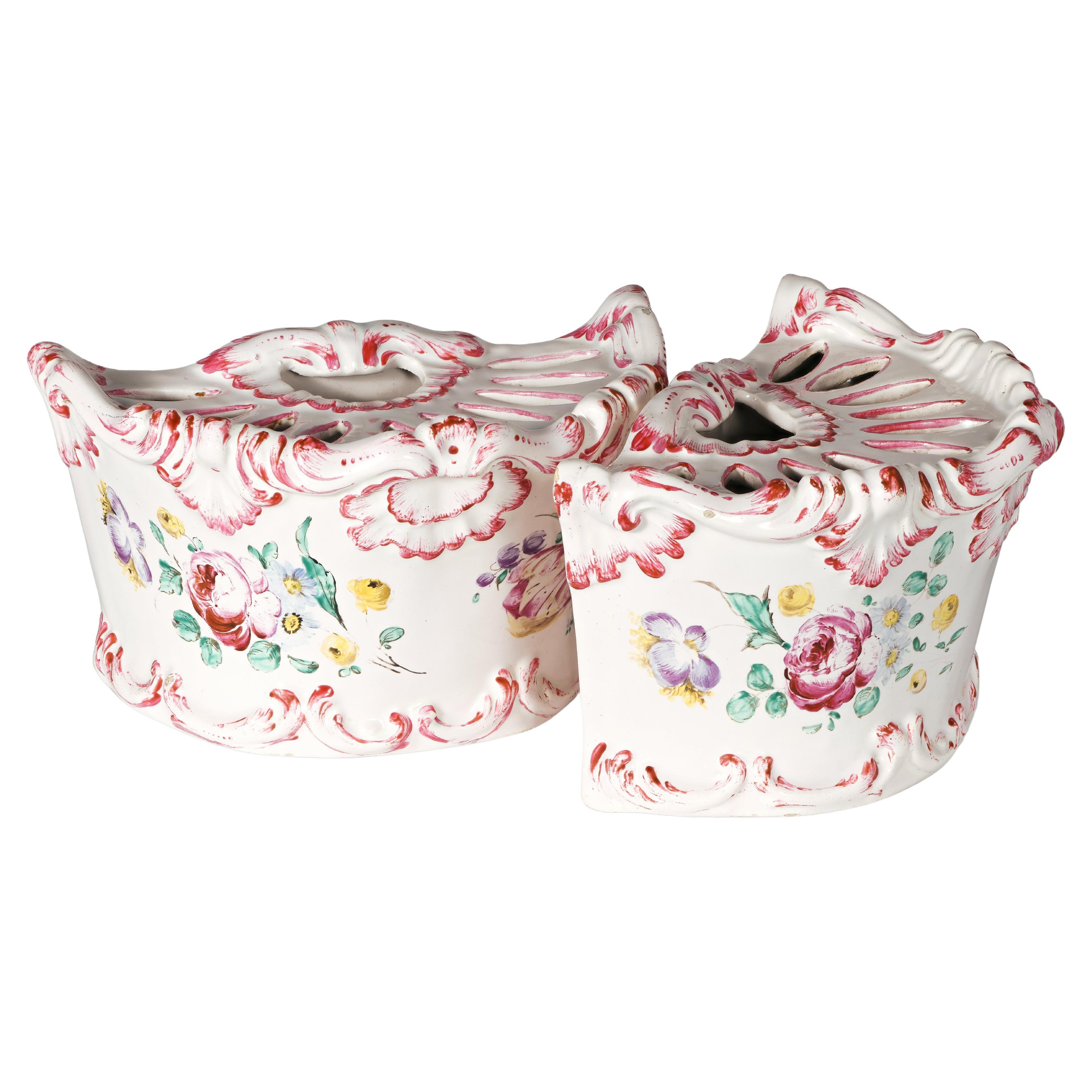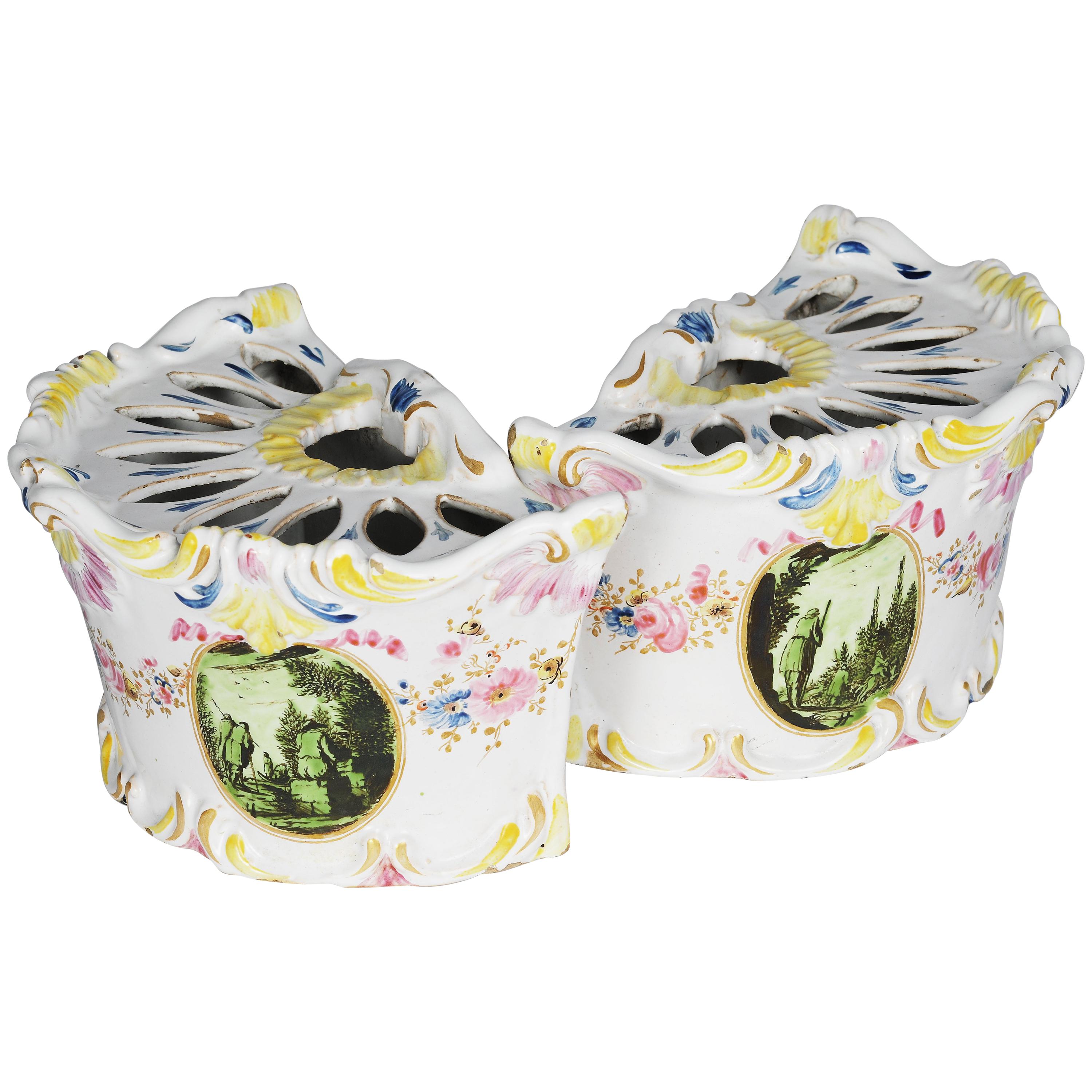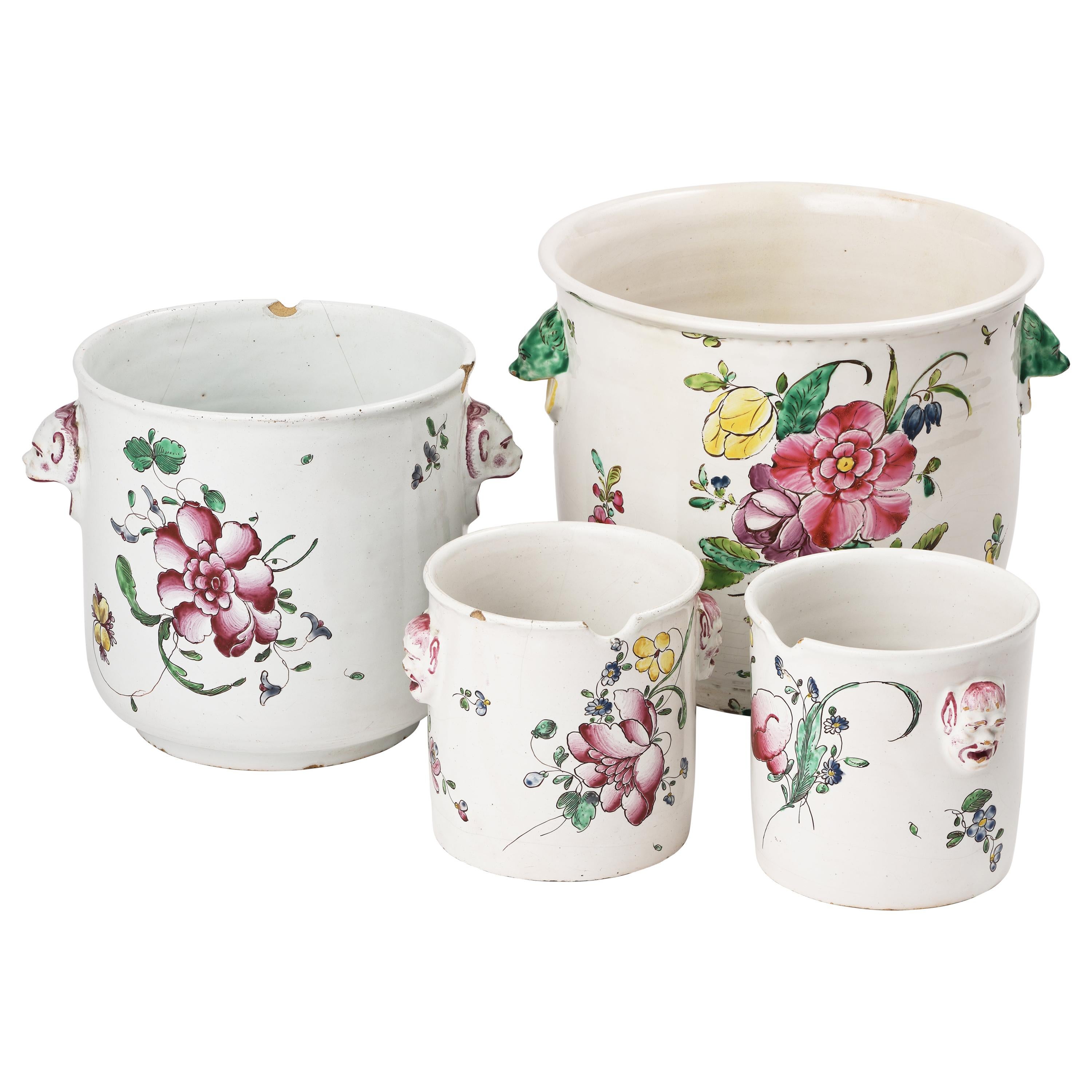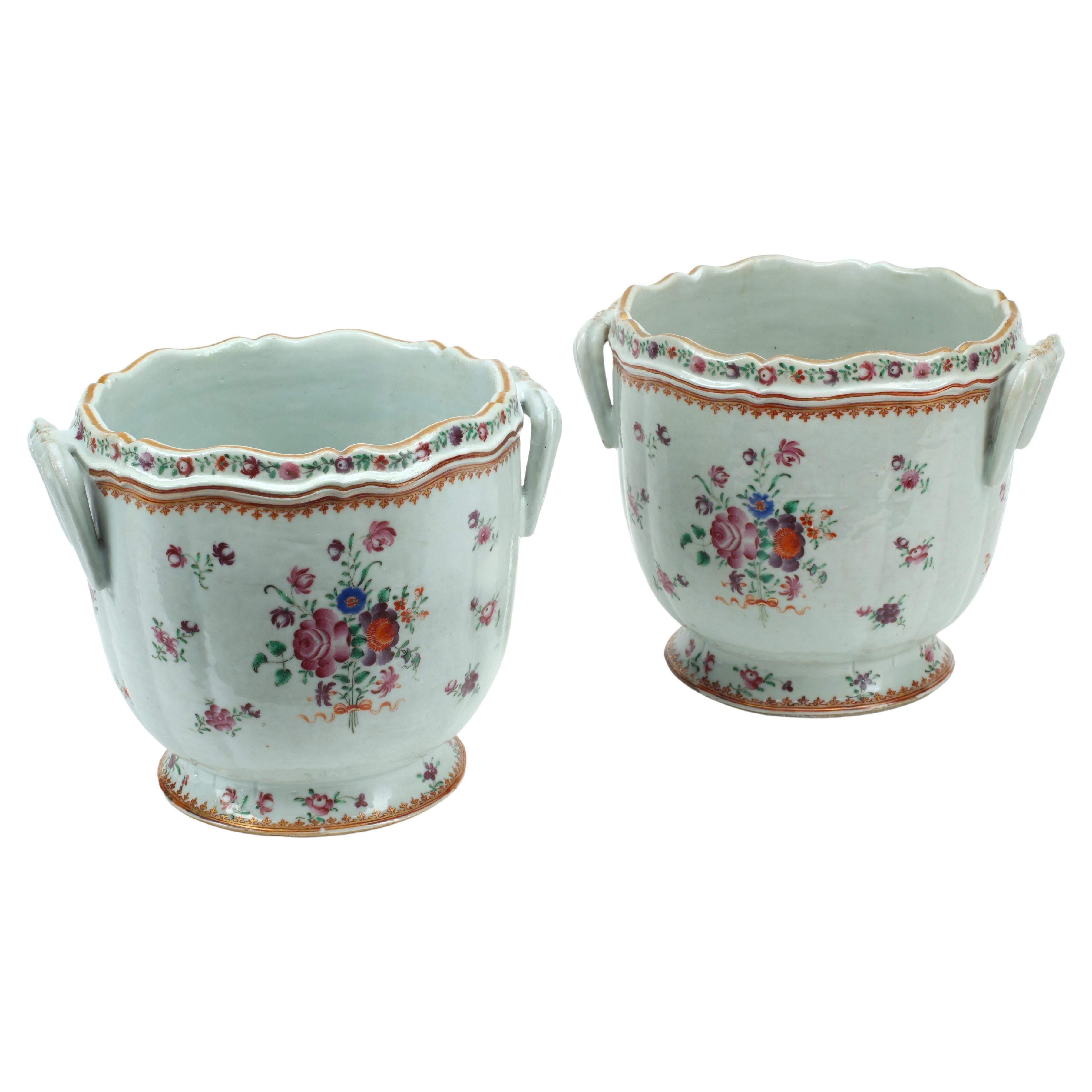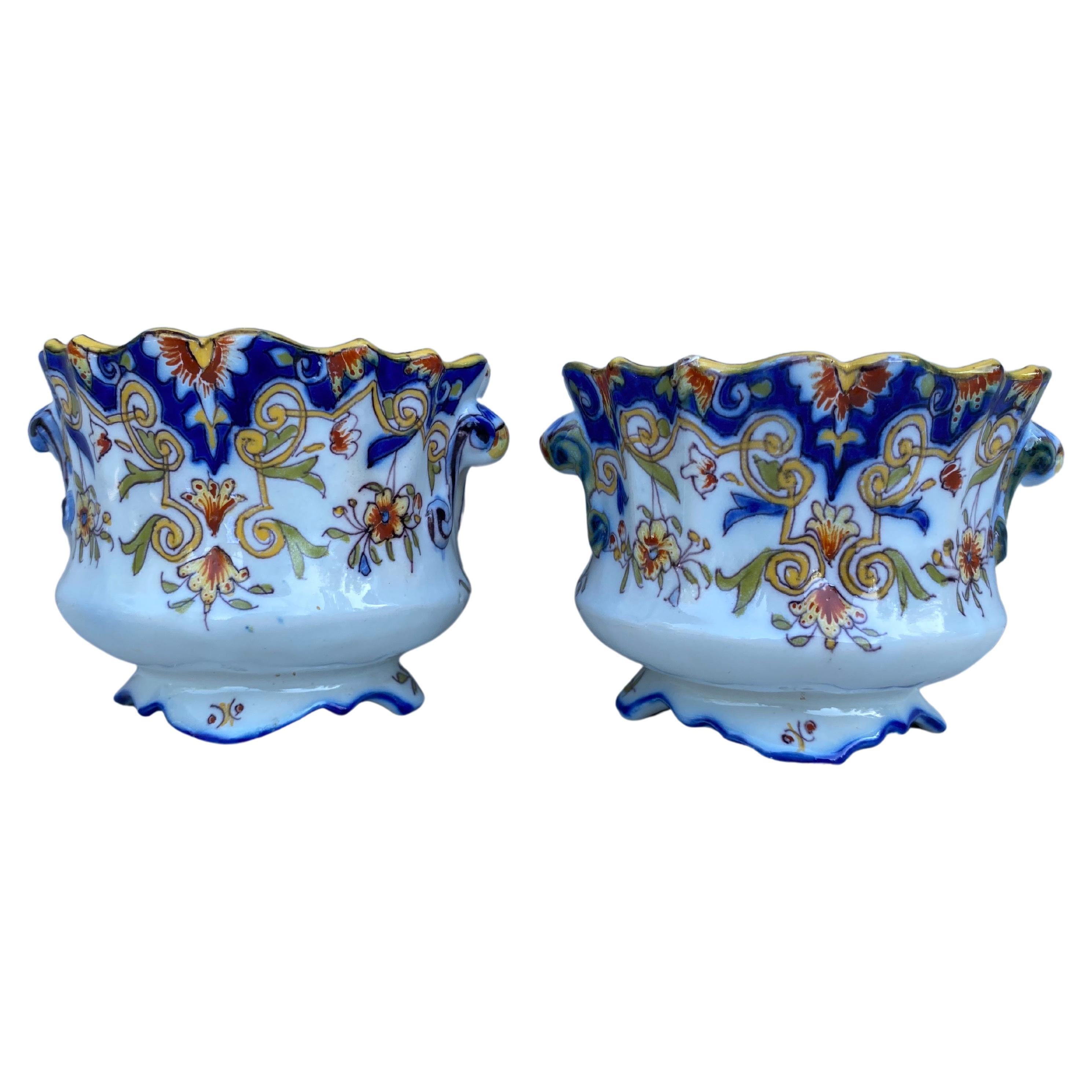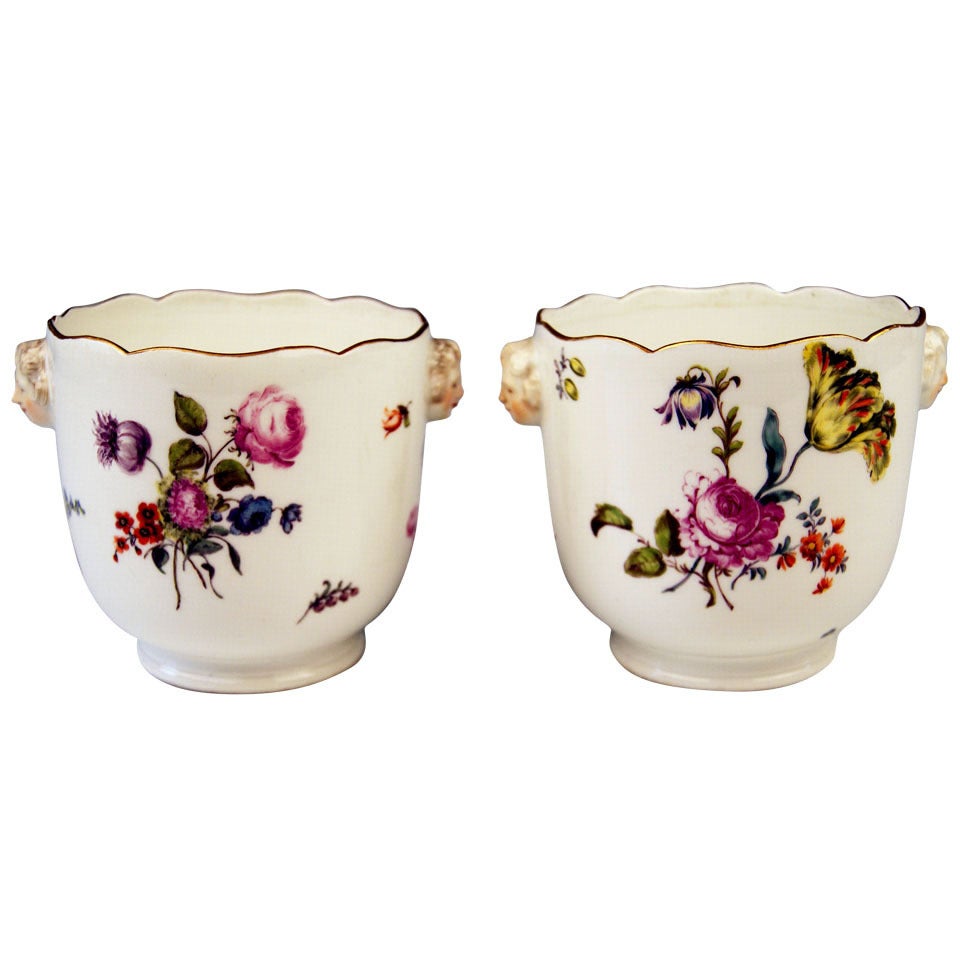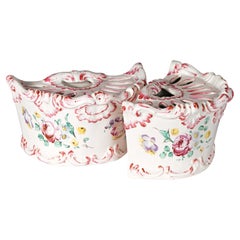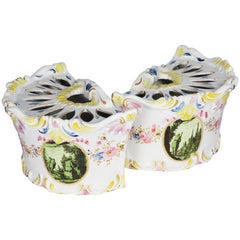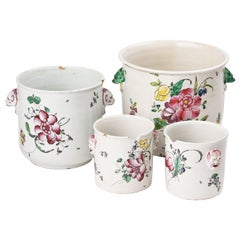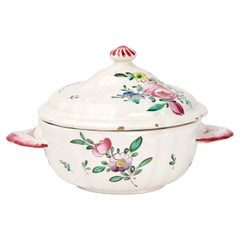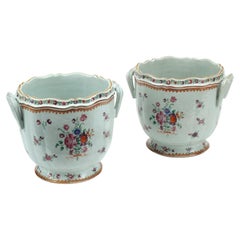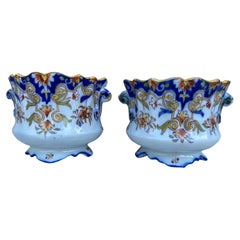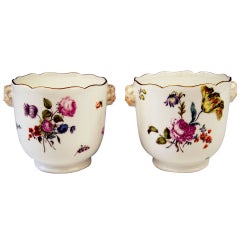Items Similar to Small Maiolica Flower Pots, Ferretti Manufacture, Lodi, circa 1770-1780
Video Loading
Want more images or videos?
Request additional images or videos from the seller
1 of 14
Small Maiolica Flower Pots, Ferretti Manufacture, Lodi, circa 1770-1780
$958.51per set
£713.42per set
€800per set
CA$1,312.93per set
A$1,460.26per set
CHF 762.50per set
MX$17,769.81per set
NOK 9,738.32per set
SEK 9,132.83per set
DKK 6,090.12per set
Shipping
Retrieving quote...The 1stDibs Promise:
Authenticity Guarantee,
Money-Back Guarantee,
24-Hour Cancellation
About the Item
Two maiolica flower pots
Antonio Ferretti Manufacture
Lodi, Circa 1770 - 1780
Maiolica polychrome decorated “a piccolo fuoco” (third fire)
They measure: 3.46 x 3.14 x 2,67 in (8.8 x 8 x 6,8 cm)
They weigh: 0.55 lb (253 g)
State of conservation: intact. One little chip.
The two small flower pots have a spherical front and a flat back with two small handles on the sides of the rim. The effect obtained is that of a small basket or bucket decorated on the front with groups of flowers painted with large brushstrokes in the bright colors typical of the third fire technique (“a piccolo fuoco”). The decoration is based on a typical bouquet of flowers gathered around a central rose.
A precise comparison comes from two specimens presented in the exhibition held in Lodi in 1995 (M. L. Gelmini, Maioliche lodigiane del ‘700, Milano 1995, p. 174, nn. 205-206).
The motif known as “alla rosa contornata” or “alla vecchia Lodi” constitutes one of the most loved decorations during the 18th century and is referred to in contemporary inventories as “fiori alla Strasburgo”.
This decorative style represented a strong point of the Lodi factory, which established itself thanks to the vivid nature of the colors made possible by the introduction of a new technique perfected by Paul Hannong in Strasbourg and later introduced by Antonio Ferretti to Italy. The production process, called “piccolo fuoco” (third fire), allowed the use of a greater number of colors than in the past; in particular, the purple of Cassius, a red made from gold chloride, was introduced. Its use allowed for many more tones and shades, from pink to purple.
The Ferretti family started their maiolica manufacturing business in Lodi in 1725.
The forefather Simpliciano started the business by purchasing an ancient furnace in 1725 and, indeed, we have evidence of the full activity of the furnaces starting from April of the same year (Novasconi-Ferrari-Corvi, La ceramica lodigiana, 1964, p. 26 n. 4). Simpliciano started a production of excellence also thanks to the ownership of clay quarries in Stradella, not far from Pavia. The production was so successful that in 1726 a decree of the Turin Chamber came to prohibit the importation of foreign ceramics, especially from Lodi, to protect internal production (G. Lise, La ceramica a Lodi, Lodi 1981, p. 59).
In its initial stages, the manufacture produced maolicas painted with the “a gran fuoco” (double fire) technique, often in turquoise monochrome, with ornamentation derived from compositional modules in vogue in Rouen in France. This was also thanks to the collaboration of painters like Giorgio Giacinto Rossetti, who placed his name on the best specimens next to the initials of the factory.
In 1748 Simpliciano made his will (Gelmini, Maioliche lodigiane del '700, 1995, p. 30) appointing his son Giuseppe Antonio (known as Antonio) as universal heir. After 1750, when Simpliciano passed away, Antonio was directly involved in the maiolica factory, increasing its fortunes and achieving a reputation on a European level. Particularly important was the aforementioned introduction in 1760 of the innovative “a piccolo fuoco” (third fire) processing, which, expanding the ornamental repertoire with Saxon-inspired floral themes, was able to commercially compete with the German porcelains that had one of its most renowned offerings in the naturalistic Deutsche Blumen. Antonio Ferretti understood and promoted this technique and this decoration, proposing it in a fresher and more corrective version, less linked to botanical tables, both with or without contour lines, as well as in purple or green monochrome. After efforts to introduce more industrial production techniques to the sector succeeded, even the Ferretti manufacture, in the last decade of the eighteenth century, started heading towards decline despite its attempts to adapt production to neoclassical tastes.
In 1796 the Napoleonic battle for the conquest of the Lodi bridge over the Adda definitively compromised the furnaces. Production resumed, albeit in a rather stunted manner, until Antonio's death on 29 December 1810. (M. L. Gelmini, Maioliche lodigiane del '700, pp. 28-30, 38, 43 sgg., 130-136 (for Simpliciano); pp. 31 sgg., 45-47, 142-192 (for Antonio).
Bibliography for maiolica from Lodi:
C. Baroni, Storia delle ceramiche nel Lodigiano, in Archivio storico per la città e i comuni del circondario e della diocesi di Lodi, XXXIV (1915), pp. 118, 124, 142; XXXV (1916), pp. 5-8;
C. Baroni, La maiolica antica di Lodi, in Archivio storico lombardo, LVIII (1931), pp. 453-455;
L. Ciboldi, La maiolica lodigiana, in Archivio storico lodigiano, LXXX (1953), pp. 25 sgg.;
S. Levy, Maioliche settecentesche lombarde e venete, Milano 1962;
A. Novasconi - S. Ferrari - S. Corvi, La ceramica lodigiana, Lodi 1964, ad Indicem;
G. Gregorietti, Maioliche di Lodi, Milano e Pavia (catal.), Milano 1964, p. 17;
O. Ferrari - G. Scavizzi, Maioliche italiane del Seicento e del Settecento, Milano 1965, pp. 26 sgg.;
G. C. Sciolla, Lodi. Museo civico, Bologna 1977, pp. 69-85 passim;
G. Lise, La ceramica a Lodi, Lodi 1981;
M. Vitali, in Storia dell'arte ceramica, Bologna 1986, p. 251;
M. A. Zilocchi, in Settecento lombardo, Milano 1991, pp. 492-496;
M. L. Gelmini, in Maioliche lodigiane del '700 (cat. mostra Lodi), Milano 1995, p. 174 nn. 205-206.
R. Ausenda, a cura di, Musei e Gallerie di Milano. Museo d’Arti Applicate. Le ceramiche. Tomo secondo, Milano 2000, p. 213.
- Creator:Antonio Ferretti (Manufacturer)
- Dimensions:Height: 3.47 in (8.8 cm)Width: 3.15 in (8 cm)Depth: 2.68 in (6.8 cm)
- Sold As:Set of 2
- Style:Rococo (Of the Period)
- Materials and Techniques:Maiolica,Glazed
- Place of Origin:
- Period:1770-1779
- Date of Manufacture:circa 1770
- Condition:They are intact. One little chip.
- Seller Location:Milano, IT
- Reference Number:1stDibs: LU4352228616932
About the Seller
4.3
Vetted Professional Seller
Every seller passes strict standards for authenticity and reliability
Established in 1860
1stDibs seller since 2018
21 sales on 1stDibs
Associations
International Confederation of Art and Antique Dealers' Associations
- ShippingRetrieving quote...Shipping from: Milano, Italy
- Return Policy
Authenticity Guarantee
In the unlikely event there’s an issue with an item’s authenticity, contact us within 1 year for a full refund. DetailsMoney-Back Guarantee
If your item is not as described, is damaged in transit, or does not arrive, contact us within 7 days for a full refund. Details24-Hour Cancellation
You have a 24-hour grace period in which to reconsider your purchase, with no questions asked.Vetted Professional Sellers
Our world-class sellers must adhere to strict standards for service and quality, maintaining the integrity of our listings.Price-Match Guarantee
If you find that a seller listed the same item for a lower price elsewhere, we’ll match it.Trusted Global Delivery
Our best-in-class carrier network provides specialized shipping options worldwide, including custom delivery.More From This Seller
View AllMaiolica flower pots Samson & Fils Factory, France, late 19th century
By Emile Samson
Located in Milano, IT
Maiolica flower pots “a mezzaluna”
Samson & Fils Factory
Montreuil-sous-Bois, France, late 19th century
They measure 4.72 in in height x 8.66 x 5.03 (12 cm x 22 x 12,8)
Weight: 1.88...
Category
Antique Late 19th Century French Rococo Planters, Cachepots and Jardinières
Materials
Maiolica
Pair of Ancient Italian Maiolica Flower Pots Milan, Rubati Factory, 1770 circa
By Pasquale Rubati
Located in Milano, IT
Maiolica flower pot “a mezzaluna”
decorated with trompe l’oeil
Pasquale Rubati Factory
Milan, circa 1770
Measures: each 4.7 in (cm 12) x 5 in (c...
Category
Antique 1770s Italian Rococo Ceramics
Materials
Maiolica
Antique Italian Maiolica Coolers Pasquale Rubati Manufacture Milan, 1770 Circa
By Pasquale Rubati
Located in Milano, IT
Assortment of bottle and glass coolers in Maiolica.
Pasquale Rubati manufacture
Milan, circa 1770
Maiolica polychrome decorated “a piccolo fuoco” (third fire)
a - Bottle cooler
5.91 in x 5.91 in diameter (15 x 15 cm )
Weight: 1.86 lb (845 g)
b - Bottle cooler
6.89 x 7.87 in diameter (17,5 x 20 cm)
Weight: 2.09 lb (948 g)
c - Pair of glass-cooler vases
3.94 x 3.94 in diameter (10 x 10 cm)
Weight: 1.43 lb (650 g)
Good state of conservation:
a - some chipping from use on the edge;
a - two fêlures covered on the edge;
c - one has deep chippings on the edge and the other a subtle fêlure.
Two Majolica factories were active in Milan in the 18th century. The first, starting from 1745, was owned by Felice Clerici; the other one by Pasquale Rubati from 1756. Rubati was in competition with Felice, whose worker he had been prior to opening his own workshop. On his death in 1796, the business was continued for a few more years by his son Carlo.
Recent studies have recognized Pasquale Rubati's contribution as the creator of "Strasbourg-style" decorations with their particularly joyful depictions. This style had previously been attributed to the Lodi manufacturers. These works here, however, are a clear example of this production.
The Majolica containers have different sizes, a cylindrical shape and rest on a low foot ring. The two largest are completed by handles in the shape of a zoomorphic mask with wide open jaws, while the smaller ones have handles applied with an anthropomorphic mask.
All the works are characterized by elegant floral decoration.
The two twin glass coolers show bunches of flowers centered around a main corolla, a rose or a peony paired...
Category
Antique 1770s Italian Rococo Ceramics
Materials
Maiolica
Italian Maiolica Cup Ferretti Lodi, circa 1770 - 1780
By Antonio Ferretti
Located in Milano, IT
Maiolica puerperal cup
Antonio Ferretti Manufacture
Lodi, Circa 1770 - 1780
Maiolica polychrome decorated “a piccolo fuoco” (third fire).
It measures: 4.3 x 6.8 x 5.3 in (11 x 17,5 x 13,5 cm)
Weight: 0.78 lb (358 g)
State of conservation: some closed pass-through fêlures on the cup, barely visible on the outside. Some use chips on the edge of the lid, two of which are more marked.
From about the mid-sixteenth century, the puerperal soup tureen or puerperal cup became one of the most popular wedding gifts in central Italy. As an auspicious symbol, it replaced the birth table (“desco da parto”) which, on the occasion of high-ranking marriages, from the thirteenth century, had been painted by famous artists, especially in Tuscany.
In France this same tureen is called "écuelle de mariée", as it is given to spouses as a sign of fertility.
During the eighteenth century this custom spread even outside Italy to all social levels. Depending on availability and rank, it was made of different materials: precious metals, maiolica, porcelain, glass, pewter, etc.
Beginning in the mid-twentieth century, the custom of this symbolic homage gradually disappeared, although famous designers such as Gio Ponti and Giuseppe Gariboldi, even as recently as the 1940s, revisited a model of a small puerperal soup bowl for the Ginori and, also in Italy in 1940, in a national competition for young potters, one of the themes of the test was indeed a modern model of a puerperal cup as an auspicious gift.
This particular cup was also called a "service cup" or "puerperal vase" or "stuffed cup" - the windows were sealed with straw to prevent drafts of air for women in labor.
In the eighteenth century the line of the puerpera cup was simplified, so much so that it took the form of a small tureen with two handles - the typical broth cup...
Category
Antique 1770s Italian Rococo Ceramics
Materials
Maiolica
Ancient Maiolica Cup, Rubati Manufacture, Milan, Circa 1770 - 1780
By Pasquale Rubati
Located in Milano, IT
Sick cup
Pasquale Rubati Manufacture
Milan, Circa 1770 - 1780
Maiolica decorated in polychrome “a piccolo fuoco” (third fire)
It measures: h 2.36 x 7.4 x 7.87 (h 6 x 19 x 20 cm)
...
Category
Antique 1770s Italian Rococo Ceramics
Materials
Maiolica
Rococo Italian Maiolica Flower Pot Pasquale Rubati, Milano, 1770 circa
By Pasquale Rubati
Located in Milano, IT
Maiolica flower pot “a mezzaluna” with support feet
decorated with little bunches of flowers
Pasquale Rubati Factory
Milan, circa 1770
5.5 in X ...
Category
Antique 1770s Italian Rococo Ceramics
Materials
Maiolica
You May Also Like
Pair of Chinese Export Polychrome Porcelain Cachepots, 18th Century
Located in El Monte, CA
This pair of 18th century Chinese Export polychrome porcelain cachepot are an exceptional example of antique porcelain made by skilled Chinese artisans for the European market. A sca...
Category
Antique 18th Century Chinese Chinese Export Planters, Cachepots and Jard...
Materials
Porcelain
19th Century Pair Of French Faience Cache Pots Desvres
By Desvres
Located in Austin, TX
19th Century Pair Of French Faience Cache Pots Desvres , hand painted with flowers on one side and coat of arms on the other side.
Category
Antique 1890s French Rustic Planters, Cachepots and Jardinières
Materials
Faience
Meissen Pair of Cachepots Planters Flower Blossoms Rococo Period c. 1750
By Meissen Porcelain
Located in Vienna, AT
Meissen gorgeous pair of cachepots / planters stunningly decorated with flower blossoms, made in Rococo Period / circa 1750.
The white porcelain ...
Category
Antique 18th Century and Earlier German Rococo Porcelain
Materials
Porcelain
$2,851 Sale Price / set
29% Off
Royal Delft Beaker Vases Earthenware Dutch Polychrome Delftware Vases a Pair
By AK Dutch Delftware, Delft, Royal Delft
Located in Wommelgem, VAN
Dutch Royal Delft Polychrome Delft vases
A pair Delftware beaker vases
The vases are hand crafted and hand painted in enchanting colors
Floral decoration Chinoiserie with birds an...
Category
20th Century Dutch Baroque Revival Delft and Faience
Materials
Ceramic, Earthenware, Delft
$1,556 / set
Free Shipping
Pair of 19th Century Hand Painted Barbotine Ceramic Vases & Matching Cache-Pot
Located in Dallas, TX
This beautiful, colorful hand painted Majolica antique set was sculpted in Montigny sur Loing, France, circa 1870. Each ceramic vase including the mat...
Category
Antique Mid-19th Century French Vases
Materials
Ceramic, Majolica
Pair Antique Porcelain Jars French Hand Painted 18th Century Made by Mennecy
By Mennecy Porcelain Manufactory 1
Located in Katonah, NY
These beautiful Mennecy porcelain soft-paste pomade jars were hand-painted in the 18th century, circa 1765. They are rare.
Jars like this would have been placed on the vanity of an ...
Category
Antique Mid-18th Century French Rococo Vases
Materials
Porcelain
More Ways To Browse
Green Glazed Pots
Antique Italian Pot
Antique Silver Cat
Antique Italian Porcelain Flowers
Flower Bucket
Antique Rococo Style Gold Table
Antique Piccolo
Furnace Flowers
Napoleonic Tables
Arte Ceramica
Table D Appoint
Used Flower Buckets
Green Glass Flower Pot
P M Porcelain
Antique Well Bucket
Chamber Pot
G C Porcelain
Rococo Fire Basket
